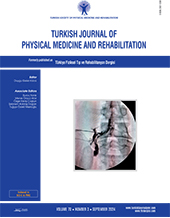Effects of intra-articular versus peri-articular dextrose prolotherapy in knee osteoarthritis: A clinical trial study
2 Department of Physical Medicine and Rehabilitation, Shiraz Medical School, Shiraz University of Medical Sciences, Shiraz, Iran
3 Department of Physical Medicine and Rehabilitation, Shiraz Medical School, Shiraz University of Medical Sciences (SUMS), Shiraz, Iran
4 Department of Internal Medicine, Shiraz University of Medical Sciences, Shiraz, Iran
5 Department of Physical Medicine and Rehabilitation, Shiraz University of Medical Sciences, Shiraz, Iran DOI : 10.5606/tftrd.2024.12937 Objectives: This study aims to compare the effectiveness of intra-articular and peri-articular dextrose prolotherapy (DPT) in patients with knee osteoarthritis (KOA) without effusion.
Patients and methods: Between August 2018 and November 2018, a total of 51 participants including 27 cases (12 males, 15 females; mean age: 55.7±5.2 years; range, 38 to 70 years) in Group A and 24 cases (9 males, 15 females; mean age: 54.7±4.6 years; range, 38 to 70 years) in Group B were recruited. Group A received intra-articular DPT, while Group B received peri-articular DPT. Treatment was administered two times with two-week intervals. The Visual Analog Scale (VAS), Western Ontario and McMaster Universities Arthritis Index (WOMAC) and Oxford Knee Scale (OKS) questionnaires were filled at baseline, and four and eight weeks after first injection.
Results: At four and eight weeks, the VAS, OKS, and WOMAC scores improved from baseline in both groups. There was no significant difference in the WOMAC and OKS scores between two methods. The VAS scores showed superiority of intra-articular method (p<0.05).
Conclusion: Both peri-articular and intra-articular DPT were effective in patients with KOA. There was no superiority in terms of functional improvement between two groups. However, intra-articular prolotherapy was more effective in decreasing pain in these patients.
Keywords : Intra-articular injection, knee, osteoarthritis, prolotherapy

















